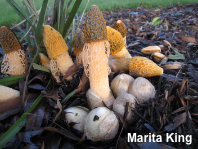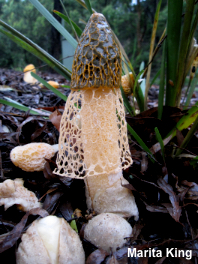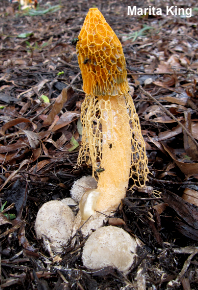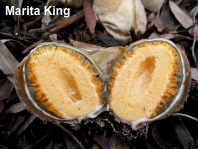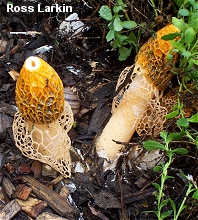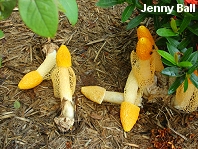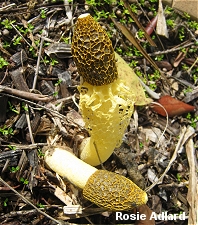| Major Groups > Stinkhorns > Phallus multicolor |

|
Phallus multicolor [ Basidiomycota > Agaricomycetes > Phallales > Phallaceae > Phallus . . . ] by Michael Kuo To judge from the "What's This Mushroom?" e-mails I receive from down under, this mushroom is one of the more common stinkhorns of Australia, along with Colus pusillus. Phallus multicolor is a "netted stinkhorn," a cousin of Phallus indusiatus that features a lemon yellow head (visible once flies have removed the brown spore slime) and a beautiful yellow skirt. The skirt is a bit shorter than the skirts of Phallus indusiatus or Phallus cinnabarinus—but a bit longer than the skirt of Phallus duplicatus. I have never collected Phallus multicolor, and I have never studied material collected by others. If you have found this amazing mushroom, I would love to make this page more scientific by studying your specimen! Please send me an email at if you would be interested in preserving the mushroom and sending it for study. Two varieties of this mushroom have been described (the typical variety, and var. laeticolor), putatively separable on the basis of the length and color of the indusium (the "net"), as well as colors of the stem and volva. However, the differences do not appear to be consistent. Dictyophora multicolor is a synonym. Description: Note: The description below is based on the photos sent to me, and on the sources cited below. I have not studied any collections of Phallus indusiatus. Ecology: Saprobic; growing alone or gregariously in woods and in urban settings (gardens, woodchip beds, and so on); year-round; Australia, New Zealand, and Hawaii; also reported from Asia—although these records may represent Phallus cinnabarinus). The illustrated specimens were photographed in Australia. Immature Fruiting Body: Like a whitish to brownish "egg" attached, at the base to purplish rhizoids; when sliced revealing the stinkhorn-to-be encased in a gelatinous substance. Mature Fruiting Body: Cylindric and phallic; to about 16 cm high and 3 cm wide; with a clearly differentiated head structure that sits atop the stem, and an ample netted structure (an "indusium") hanging from the bottom of the head. Head: To about 4 cm high; conic to broadly conic; often becoming perforated at the apex; pitted and pocketed in a reticulate pattern; surface lemon yellow, but covered with a thick layer of dark brown spore slime that eventually wears off or is carried away by insects. Stem: To about 12 cm high and 2 cm wide; more or less equal; dry; yellow to pale yellow or whitish; finely pocked; hollow; base enclosed in a brown to purple brown volva that is sometimes spiny with scattered white spines. Indusium (Net): Extending about halfway to the ground; pale yellow; widely reticulate. Odor: Sweet but unpleasant. Microscopic Features: Spores 3.5–4.5 x 1.5–2 µm; long-ellipsoid to nearly cylindric. REFERENCES: (M. J. Berkeley & C. E. Broome, 1882) M. C. Cooke, 1882. (Saccardo, 1888; Cunningham, 1944/1979; Reid, 1977; Kreisel, 1996; Calonge, 2005; Hosaka et al., 2006; Hemmes & Desjardin, 2009; Kreisel & Hausknecht, 2009; Hosaka, 2010; Hosaka, 2012; Li et al., 2016; Song, 2018.) This site contains no information about the edibility or toxicity of mushrooms. |
© MushroomExpert.Com |
|
Cite this page as: Kuo, M. (2021, November). Phallus multicolor. Retrieved from the MushroomExpert.Com Web site: http://www.mushroomexpert.com/phallus_multicolor.html |
